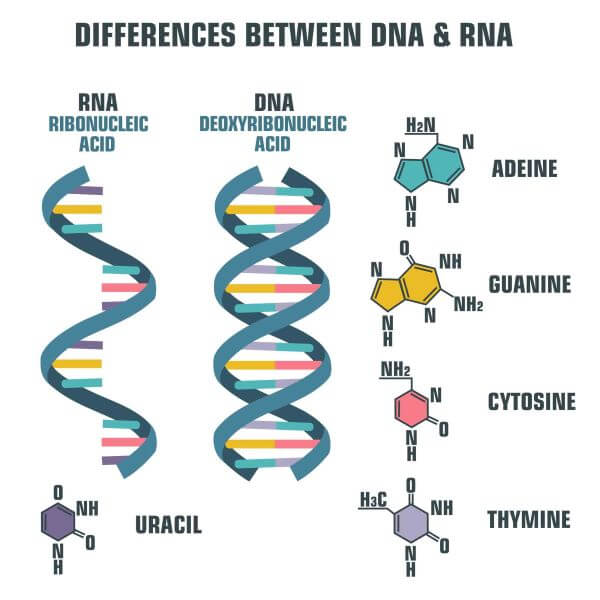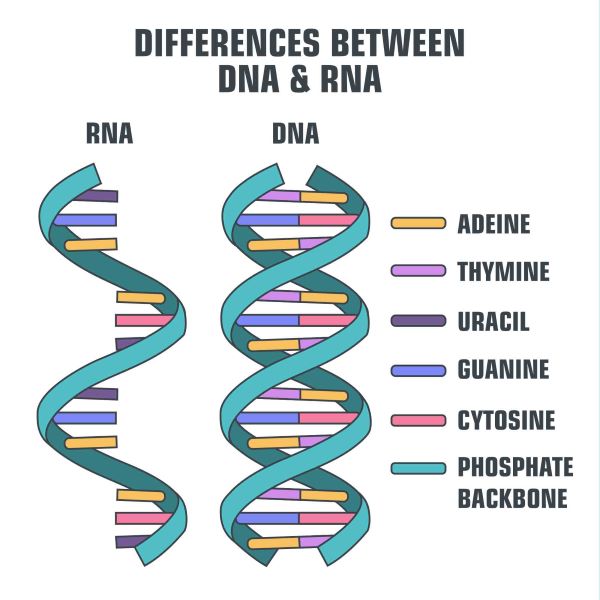DNA and RNA are both types of nucleic acids, large molecules that are made up of monomers called nucleotides. Nucleic acids are used to store genetic information, which the cell uses to make proteins. Although DNA and RNA share many similarities, there are several key structural and functional differences between these two molecules.

What Are Nucleic Acids?
DNA and RNA are both types of nucleic acids, which are large molecules found in all living cells and viruses.
Nucleic acids are the information-carrying molecules of the cell. They store all the genetic material of an organism, which is passed on to offspring (inherited) when the organism reproduces. They also play important roles in essential cellular processes, such as cell division and protein synthesis.
What is DNA?
DNA stands for deoxyribonucleic acid. It is the information molecule and stores all the genetic material of a cell. It also contains instructions for the synthesis of other molecules, like proteins.
DNA is a polymer and is made of many smaller molecules (AKA monomers) called nucleotides. Each nucleotide contains a phosphate group, a 5-carbon sugar, and a nitrogenous base. The four types of nitrogenous bases in DNA molecules are:
- Adenine
- Thymine
- Guanine
- Cytosine
The type of nitrogenous base determines the type of nucleotide. The four types of nucleotide are:
- A nucleotide (containing adenine)
- T nucleotide (containing thymine)
- G nucleotide (containing guanine)
- C nucleotide (containing cytosine)

The sequence of nucleotides in a DNA molecule determines the instructions contained in that stretch of DNA. Nucleotides are joined together by phosphodiester bonds, which form between the 3’ carbon atom of one nucleotide and the 5’ carbon atom of another.
A string of nucleotides all joined together makes a DNA strand. Each DNA molecule contains two strands, which are twisted around one another to form a structure called the double helix. The nucleotides that make up each DNA strand are joined together by hydrogen bonds. These bonds form between specific nitrogenous bases, known as base pairs. The base pairs in DNA molecules are:
- Adenine (A) – Thymine (T)
- Cytosine (C) – Guanine (G)

What is RNA?
RNA stands for ribonucleic acid. Its function is to carry out the instructions encoded in DNA. There are three types of RNA, each with a different function. These are:
Messenger RNA (mRNA) – mRNA carries information for protein synthesis from the DNA molecules in the nucleus to the ribosomes
Ribosomal RNA (rRNA) – rRNA is a structural component of ribosomes (the organelles that perform protein synthesis)
Transfer RNA (tRNA) – tRNA transfers amino acids to the ribosome. These amino acids are used to assemble a new polypeptide chain

RNA is made up of ribonucleotides, each containing a phosphate group, a 5-carbon sugar, and a nucleotide base. The four types of nitrogenous base found in RNA molecules are:
- Adenine
- Uracil
- Guanine
- Cytosine
Therefore, the four types of RNA nucleotide are:
- A nucleotide (containing adenine)
- U nucleotide (containing uracil)
- G nucleotide (containing guanine)
- C nucleotide (containing cytosine)
Like in DNA molecules, these ribonucleotides are joined together by phosphodiester bonds that form between the 3’ carbon of one sugar and the 5’ carbon of another. Unlike DNA, RNA is a single-stranded molecule; however, it can still form double-stranded structures.
The base pairs in RNA molecules are:
- Adenine (A) – Uracil (U)
- Cytosine (C) – Guanine (G)
DNA vs. RNA
DNA |
RNA |
| Stores genetic information for the cell | Uses the information stored in DNA to make proteins |
| Contains the 5-carbon sugar deoxyribose | Contains the 5-carbon sugar ribose |
| Double-stranded | Single-stranded |
| Contains thymine | Contains uracil |
| Self-replicating | Synthesised by transcription |
Similarities Between DNA and RNA Molecules
DNA and RNA are both types of nucleic acid, and there are several similarities between the two.

Nucleotides and Ribonucleotides
The nucleotides of DNA and the ribonucleotides that make up RNA are very similar in structure. Both contain a phosphate group, a 5-carbon sugar, and a nitrogenous base.
Phosphodiester Bonds
In both DNA and RNA molecules, monomers are joined together by phosphodiester bonds that form between the 3’ carbon of one molecule and the 5’ carbon of the next.
Number of Nitrogenous Bases
DNA and RNA molecules both contain four nitrogenous bases. Three of these (adenine, cytosine, and guanine) are found in both types of nucleic acid.
Sugar-Phosphate Backbone
Both DNA and RNA molecules are made up of a sugar-phosphate backbone with nucleotide bases sticking out.

Differences Between DNA and RNA Molecules
There are also several differences between DNA and RNA molecules. These are:
Type of Sugar
The 5-carbon sugar found in DNA is deoxyribose, whereas RNA contains the sugar ribose.
Nitrogenous Bases
DNA contains the bases cytosine, guanine, adenine, and thymine, whereas RNA contains cytosine, guanine, adenine, and uracil.
Base Pairing
Base pairing is slightly different in DNA and RNA molecules. The base pairs in DNA molecules are:
- Adenine (A) – Thymine (T)
- Cytosine (C) – Guanine (G)
Whereas the base pairs in RNA molecules are:
- Adenine (A) – Uracil (U)
- Cytosine (C) – Guanine (G)
Strand Number
DNA is a double-stranded molecule; RNA is a single-stranded molecule.

Function
DNA and RNA molecules have different functions. DNA stores genetic information for the cell, whereas RNA codes for amino acids and acts as a messenger between DNA molecules and the ribosomes.
Replication
DNA molecules are self-replicating, whereas RNA molecules are synthesized by a process called transcription.
